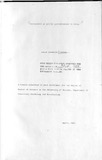| dc.description.abstract | Bovine leptospirosis is a worldwide problem and is of economlc
importance. The losses are due to abortions, stillbirths,
infertility, reduced weight galns, decreased milk production and
death. The disease in cattle may also be a source of infection to
man.
Most detailed investigations of the disease have been carried
out in Europe, Australia, New Zealand, North and South America and
South East Asia. Relatively little is known of Leptospira
infections in African livestock. No extensive countrywide surveys
have been carried out to determine the occurrence of leptospiral
serovars in Kenya.
Two thousand eight hundred and sixty four bovine serum
samples were collected from different ecological zones of Kenya,
during the period 1980 to 1982). Each serum sample was screened
against the following leptospiral serovars: L. copenhageni,
L. mankarso, L. sejroe, L. autumnalis, L. wolffi, L. georgia,
L. grippotyphosa, L. pomona, L. hardjo and L. canicola using the
microscopic agglutination technique. positive sera were then
titrated to find the end point titre.
Leptospiral antibodies were detected In 41% of the bovine
sera tested, 25% of the sera showing microscopic agglutination
(MA) titres of 1:200 or greater.
High antibody titres against L. hardjo (14.7%), L. wolffi
(10.8%) and L. grippotyphosa (9.2%), were observed, respectively.
Titres to the other leptospiral serovars were infrequent and in general did not exceed 1:200.
L. grippotyphosa infections were found to be more prevalent
in the wetter areas (zone II and zone III) while L. hardjo
infections were more widespread throughout the country with a
higher incidence in the drier areas (zone IV and zones V and VI).
It was concluded that bovine leptospirosis has a high
incidence in Kenya and control measures must, therefore, be
instituted to control the disease. | en |

